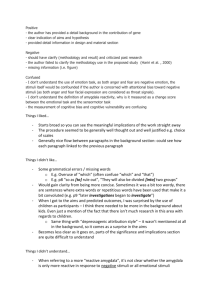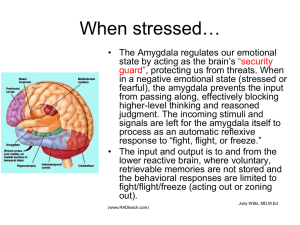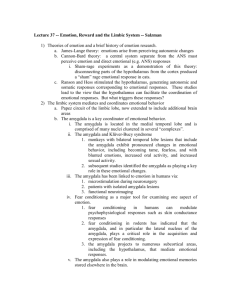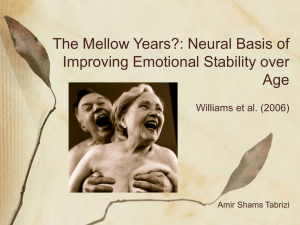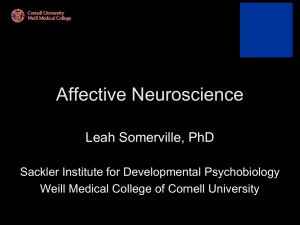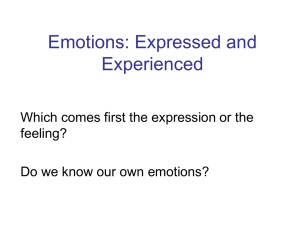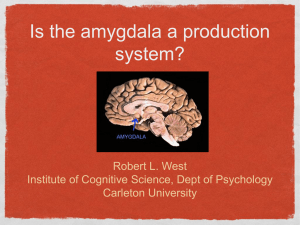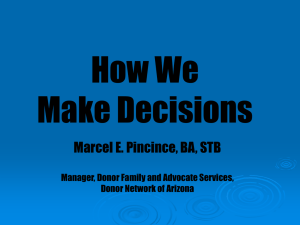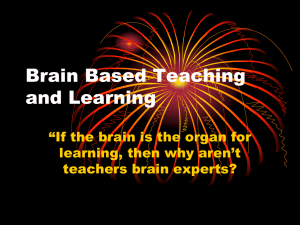Brain Plasticity and Emotional Regulation
advertisement
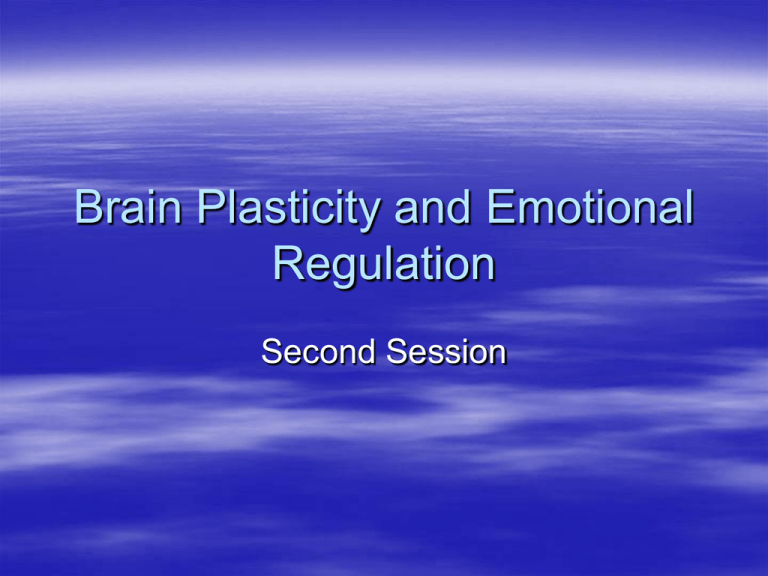
Brain Plasticity and Emotional Regulation Second Session What is Brain Plasticity? Term is in vogue, but what do we really mean? Pliable and changeable. It’s really been several “Decades of the Brain”. Dalai Lama has held numerous conferences in India to discuss breakthroughs in Neuroscience. The brain isn’t fully formed (especially, PFC) until the mid-20’s, but remains plastic throughout life. We can’t forget what a revolutionary discovery it is that the human brain can change itself. Hebb’s Axiom Neurons the fire together wire together! Localization is NOT fixed Most neuroscientists believed that the brain was “hard-wired” and specialized to the point that one area could never do the work of another (cf. Doidge, Schwartz) Michael Merzninich and Fast Forward Eduard Taub and the Silver Spring Monkeys (de-afferented their arms) and forced them to learn to eat. But Plasticity is Competitive And therefore, can be positive or negative. Even, individual neurons get more specific with training. Then when they are trained and become efficient, they become faster. Concert violinists have more neurons for the tips of their fingers than the average person. Hormonal Assist Levi-Montalcini discovered NGF (nerve growth factor). One caught Merzenich’s attention: brainderived neurotrophic factor (BDNF) which plays a crucial role in reinforcing plastic changes. It also promotes the growth of the thin fatty coat around every neuron that speeds up the transmission of electrical signals. Down Regulation of Emotion 1) Emotions arise when an individual attends to a situation and sees it as relevant to his or her goals. 2) Emotions are multifaceted, whole-body phenomena that involve loosely-coupled changes in the domains of subjective experience, behavior, and central and peripheral physiology. 3) They can interrupt what we are doing and force themselves on our awareness. It is this third element that is most crucial for an analysis of emotion regulation. The Modal Model of Emotion Situation Attention Appraisal Response O--------------O--------------O------------O Emotion Regulation Strategies 1) Situation Selection 2) Situation Modification 3) Attentional Deployment 4) Cognitive Change 5)Response Modulation Situation Selection Taking actions that make it more (or less) likely that we will end up in a situation we expect will give rise to desirable (or undesirable) emotions. Situation Modification Sometimes, efforts to modify a situation will bring a new situation into being. A related issue becomes the social consequences of emotion expression. Attentional Deployment Refers to how individuals direct their attention within a given situation in order to influence their emotions. “Distraction” focuses attention away from the situation and “Concentration” draws attention to emotional features of a situation. When this occurs repetitively, it is referred to as rumination, i.e. ruminating on sad events leads to longer and more severe depressive symptoms. Cognitive Change Refers to changing how we “appraise” the situation we are in to alter its emotional significance, either by changing how we think about a situation or about our capacity to manage the demands it poses. Is physiological arousal prior to a sports event competence enhancing (“getting pumped up”) or debilitating (“stage fright”) Reappraisal- changing a situation’s meaning in a way that alters its emotional impact. (cf. research in Post-Traumatic Growth). Response Modulation Though this occurs late in the emotion-generative process, it refers to influencing physiological, experiential, or behavioral responding as directly as possible. Exercise and relaxation can decrease physiological aspects of negative emotion (but alcohol, drugs, cigarettes, and even food can modify emotion experience. One key seems to be finding ways of expressing the emotions in adaptive rather than maladaptive ways. Prefrontal-Amygdala Interactions in the Regulation of Fear The nervous system of every living thing is but a bundle of predispositions to react in particular ways upon the contact of particular features of the environment (James, 1884) The study of emotion regulation is intimately associate with the concept of inhibition, namely, higher cortical functions are responsible for inhibiting subcortical areas. Thus, the term: “down regulation” Amygdala The lateral amygdala (LA) projects to the central nucleus of the Amygdala (Ce) directly and via the basal amygdala nuclei. The Ce is the origin of amygdala outputs to fear generating structures in the hypothalamus and brainstem. (LeDoux et al 1988). LA is seen as the site of fear memory, while Ce is seen as the site of fear expression (LeDoux, 2000). Relationship to Anxiety In this paradigm, it has been suggested that anxiety disorders may result from a lack of balance between fear and safety memories (Quirk & Gehlert, 2003). Therefore, modulation of amygdala plasticity and/or output would be an efficient way of regulating fear expression. Our friend “GABA” Situated between the BLA (Basal Lateral Amygdala) and Ce are islands of GABA (gammaamnobutyric aced)-ergic “intercalated” (ITC) cells. These cells receive input from BLA and project to Ce output neurons, thereby acting as an inhibitory interface between centers of fear learning and fear expression. Thus, the amygdala is capable of learning fear associations and fear inhibition. PFC and the Amygdala Recent studies point to the medial prefrontal cortex (mPFC) as a possible inhibitor of fear in extinction (Quirk, 2006). Early studies implicated the primate ventromedial prefrontal cortex (vmPFC) in extinction of appetitive conditioning. It is connected to the infralimbic (IL) and prelimibic (PL) sub-regions. IL is therefore well situated to inhibit the expression of fear either via the amygdala or by acting directly on lower centers. The hippocampus Inactivation of the hippocampus prior to extinction training leads to impaired recall of extinction (fear) (Corcoran et al, 2005). Direct projections from the hippocampus to the amygdala are sufficient for contextual extinction. Preliminary applications to PTSD Long after the probability of danger has decreased, the person is unable to inhibit the expression of the latent fear associations. This may be associated with pathology in the prefrontalamygdala system. Specifically, inhibition of the amygdala by the vmPFC has been associated with anxiety and mood disorders. These individuals also show impairments in a functional network involving the amygdala and anterior cingulate cortex (ACC). Thus, they exhibit a negative correlation between vmPFC activity (underactive) and amygdala activity (overactive). These same ventral prefrontal area are also compromised in major depression…(Pesawas et al.,2005). Rats exposed to an early life stressor related to maternal care develop permanent alterations in GABA-ergic function in vmPFC and amygdala (Caldji et al. 2003). Daily chronic restraint decreases dendritic branching and reduces the density of synaptic spines in vmPFC. In the amygdala, chronic restraint has the opposite effect, causing increased dendritic branching and reduces density of synaptic spines in vmPFC. These findings suggest that chronic stress increases the ability of the amygdala to learn and express fear associations, while at the same time reducing the ability of the prefrontal cortex to reduce fear. This situation (the vicious cycle in with increased fear and anxiety leads to more stress, which leads to further dysregulation) has been termed “allostatic load”. Prefrontal changes appear reversible, but amygdala changes do not (Radley et al., 2005) Treatment Implications High-frequency stimulation of the IL directly or indirectly via its thalamic afferent, improves longterm extinction (Quirk et al. 2006). Extinction learning can also be augmented with systemic drugs including dopamine agonists, noradrenergic agonists, and cannabinoid agonists( Chhatwal et al., 2005) Additional approaches to activating the PFC include repetitive Transcranial Magnetic Stimulation (Cohen et al., 2004), deep brain stimulation (Abelson et al.,2005) or even meditation (Lasar et al., 2000)
